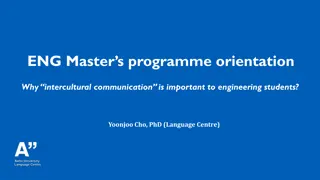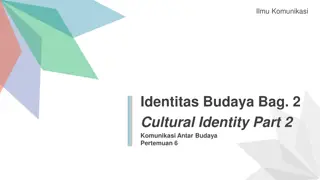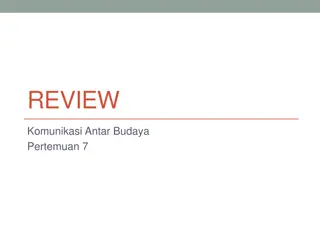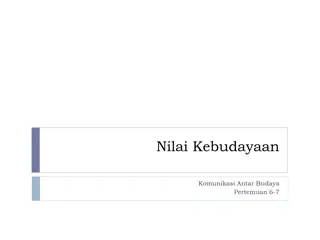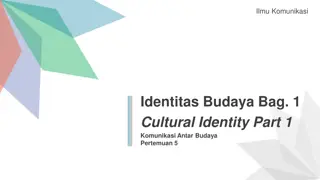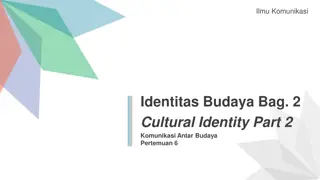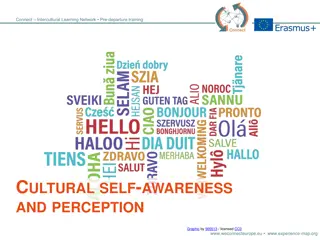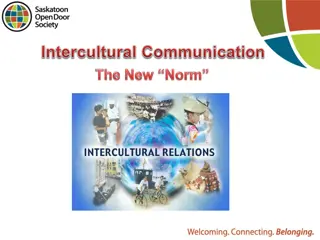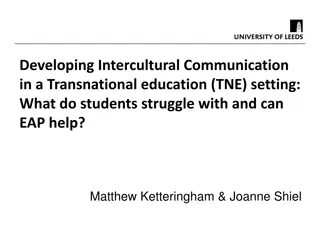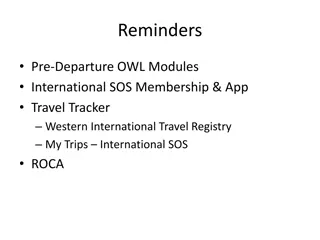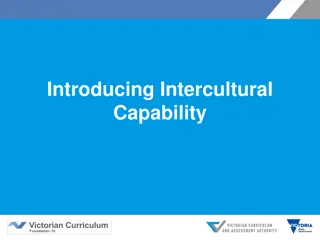Comprehensive Review of Interpretive and Intercultural Communication in World Language Education
Exploring modules 7 and 8, this lab delves into the importance of Interpretive Communication in language education, analyzing Massachusetts World Languages Standards, and offering insights into implementing these standards in the classroom. Sample unit plans and discussions enrich educators on applying these learnings effectively.
- World Language Education
- Interpretive Communication
- Curriculum Alignment
- Massachusetts Standards
- Classroom Implementation
Download Presentation

Please find below an Image/Link to download the presentation.
The content on the website is provided AS IS for your information and personal use only. It may not be sold, licensed, or shared on other websites without obtaining consent from the author. Download presentation by click this link. If you encounter any issues during the download, it is possible that the publisher has removed the file from their server.
E N D
Presentation Transcript
Massachusetts World Languages Framework Curriculum Alignment Lab #3 [Insert DATE] [Insert Names and Titles of Presenters]
Overview Today we will Briefly review the content of Online Modules 7 and 8 Explore and discuss sections of the Curriculum Alignment Guide for Unit Planning with a focus on Interpretive and Intercultural Communication View and discuss sample unit plans with a focus on Interpretive and Intercultural Communication Discuss ways in which you can apply what you ve learned to your own classroom 2 Massachusetts Department of Elementary and Secondary Education
Review and Discussion: Modules 7 and 8 Review and Discussion: Modules 7 and 8
Module 7 Review Overview Explains the Interpretive Communication mode and why it s important for world language education Explores the Massachusetts World Languages Standards for Interpretive Communication Discusses how to address the Interpretive Communication Standards in the classroom 4 Massachusetts Department of Elementary and Secondary Education
Module 7 Review What do students do in the mode of Interpretive Communication? Exercise age and development-appropriate reading, viewing, and listening skills across a variety of genres as they engage with a text Demonstrate understanding of the characteristics and viewpoints of multiple cultures and communities Demonstrate understanding of messages, main ideas, and supporting details in written, spoken, or signed texts on a variety of topics in the target language 5 Massachusetts Department of Elementary and Secondary Education
Module 7 Review What are the Interpretive Communication Standards? Descriptions of Interpretive Communication skills that students demonstrate at different levels of proficiency Each Interpretive Communication Standard contains two Functions numbered 1.a and 1.b 6 Massachusetts Department of Elementary and Secondary Education
Module 7 Review How do the Functions progress across proficiency levels? Functions Proficiency Levels NL NM NH IL IM IH AL AM AH S a. + + + + b. + + + + + + + + 7 Massachusetts Department of Elementary and Secondary Education
Module 7 Review How can I address the Interpretive Communication Standards in my classroom? Select a goal or Can-Do statement aligned with the Standards for targeted proficiency level(s) Design an aligned assessment task that use of comprehension strategies Incorporates age- and proficiency-level appropriate authentic resource(s) Inform subsequent Interpersonal and Presentational Communication task(s) Provide continuous meaningful opportunities to engage with a variety of types of texts representing diverse perspectives Design learning experiences with all students in mind, including students with disabilities and students from diverse linguistic, racial, and cultural backgrounds Connect to Deeper Learning through opportunities for students to demonstrate Mastery and Identity 8 Massachusetts Department of Elementary and Secondary Education
Module 7 Review Questions? 9 Massachusetts Department of Elementary and Secondary Education
Module 8 Review Overview Explains the Intercultural Communication mode and why it s important for world language education Explores the Massachusetts World Languages Standards for Intercultural Communication Discusses how to address the Intercultural Communication Standards in the classroom 10 Massachusetts Department of Elementary and Secondary Education
Module 8 Review What do students do in the mode of Intercultural Communication? Read, listen, and view through the lens that the message s originator intended Select language and topics that will be comprehensible to their audience or interlocutor(s) Employ culturally appropriate nonverbal behaviors to set at ease or not offend their audience or interlocutor(s) 11 Massachusetts Department of Elementary and Secondary Education
Module 8 Review What are the Intercultural Communication Standards? Descriptions of Intercultural Communication skills that students demonstrate at different levels of proficiency Each Intercultural Communication Standard contains between three and five Functions numbered 4.a-4.e 12 Massachusetts Department of Elementary and Secondary Education
Module 8 Review How do the Functions progress across proficiency levels? Functions Proficiency Levels NL NM NH IL IM IH AL AM AH S a. + + + + + b. + + + c. + + d. e. 13 Massachusetts Department of Elementary and Secondary Education
Module 8 Review How can I address the Intercultural Communication Standards in my classroom? Select a goal or Can-Do statement aligned with the Standards for targeted proficiency level(s) Embed Intercultural Communication into Integrated Performance Assessment tasks and rubrics and/or use alternative assessments Provide opportunities for students to observe, compare, reflect, interact, and reflect again to develop intercultural competence 14 Massachusetts Department of Elementary and Secondary Education
Module 8 Review Questions? 15 Massachusetts Department of Elementary and Secondary Education
Questions for Reflection Q&A in the Main Room o What are your students able to do in Interpretive and Intercultural Communication? o How might you address Interpretive Communication in your classroom? o How might you address Intercultural Communication in your classroom? 16
Discussion Questions Discussion in Breakout Rooms o How do you currently address Interpretive Communication in your classroom? o How do you currently address Intercultural Communication in your classroom? o How might you add to your current approaches based on Modules 7 and 8? 17
Exploring the Curriculum Alignment Guide Exploring the Curriculum Alignment Guide
Curriculum Alignment Guide for Unit Planning (1/5) Unit Overview In the Unit Goals/Objectives section, think about what you want students to be able to do in Interpretive and Intercultural Communication by the end of the unit Refer to the Centering Student Diversity box when creating goals/objectives for these modes! 19 Massachusetts Department of Elementary and Secondary Education
Curriculum Alignment Guide for Unit Planning (2/5) Standards Summary What Interpretive and Intercultural Standards will you focus on? Are there other standards you would like to integrate and address via Interpretive and Intercultural Communication in this unit? 20 Massachusetts Department of Elementary and Secondary Education
Curriculum Alignment Guide for Unit Planning (3/5) Summative Assessment Consider how students will show what they can do in the Interpretive and Intercultural modes How can you differentiate your tasks? How can you represent your students backgrounds, identities, and experiences? How can you measure student performances? How can you provide feedback on student performances? Consider how to simultaneously assess embedded standards of Cultures, Comparisons, Connections, and Communities Remember to provide opportunities for students to demonstrate Mastery, Identity, and Creativity * * * * * * * * * 21 Massachusetts Department of Elementary and Secondary Education
Curriculum Alignment Guide for Unit Planning (4/5) Instruction p. 1 Consider what learning activities will support students in meeting unit goals/objectives for Interpretive and Intercultural Modes How will you check for understanding and determine if additional supports are needed? What culturally relevant authentic resources will you use? What supporting language functions, grammatical structures, and vocabulary do students need in their toolbox? Consider how to simultaneously teach embedded standards of Cultures, Comparisons, Connections, and Communities Remember to provide opportunities for students to demonstrate Mastery, Identity, and Creativity * * * * * * * 22 Massachusetts Department of Elementary and Secondary Education
Curriculum Alignment Guide for Unit Planning (5/5) Instruction p. 2 Consider what materials and strategies will support students in meeting unit goals/objectives for Interpretive and Intercultural Modes How will you address Social and Emotional Well-Being and Social Justice? How will you ensure equity and representation? How will you integrate technology, and what supports will be needed? How will you use Core Practices to enhance student learning? 23 Massachusetts Department of Elementary and Secondary Education
Demonstration and Discussion: Sample Unit Plans Demonstration and Discussion: Sample Unit Plans
Space for sample unit plans Insert samples when available 25 Massachusetts Department of Elementary and Secondary Education
Discussion in the Main Room Discussion Questions What did you notice about Interpretive Communication in these samples? What did you notice about Intercultural Communication in these samples? How do these plans ask students to demonstrate Mastery, Identity, and Creativity through these modes of Communication? 26
Application and Discussion Application and Discussion
Discussion in Breakout Rooms Discussion Questions What did you learn in Modules 7 and 8 that will help you in your teaching? What are some strengths of the sample unit plans? How could they be improved? What ideas and questions do you have to share about aligning your own units using the Curriculum Alignment Guide? 28
Wrap-up and Next Steps Wrap Up and Next Steps
Preview and Next Steps In our next Curriculum Alignment Lab, we will Review Modules 9, 10, and 11 Explore sections of the Curriculum Alignment Guide for Unit Planning with a focus on Cultures and Comparisons View and discuss sample unit plans with a focus on Cultures and Comparisons Discuss ways in which you can apply what is learned to your own classroom 30 Massachusetts Department of Elementary and Secondary Education
Check for Learning Check for Learning What is Interpretive Communication? How is Interpretive Communication addressed in the Curriculum Alignment Guide? What is Intercultural Communication? How is Intercultural Communication addressed in the Curriculum Alignment Guide? 31
Thank you THANK YOU [Enter names of presenters] [Enter contact info] www.doe.mass.edu worldlanguages@mass.gov 75 Pleasant Street, Malden, MA 02148



